Signs and Symptoms of Breast Cancer
The first sign of breast cancer is usually a lump in the breast. These lumps are commonly detected with a mammography, physical exam, or a different detection technique.
While mammography is superior to other detection methods, it is not a substitute for getting to know your breasts and conducting self-breast exams routinely.
Self-Breast Exam
To detect a lump, you need to know how your breasts usually feel.
The best way to know what your breasts feel like is to conduct a self-breast exam in the shower every month after your menstrual period or pick a date each month that you will perform a self-breast exam if you no longer have periods.
Examine each breast and the surrounding tissues including those under your armpits. Your surrounding tissues contain lymph nodes which can become enlarged if breast cancer is present.
Lumps in the Breast
Many women have dense or naturally lumpy breasts and detecting a lump in a firm, or lumpy tissue can be challenging.
While conducting your self-breast exam note any areas that feel different than they did the previous month. Most lumps in breasts that are cancerous are painless.
They are often very tiny when detected. Expert diagnosis is needed to evaluate what lesions are. Cancerous lumps usually feel very different than noncancerous lumps or cysts. Cysts are usually tender and smooth. They may increase or decrease inside in size during the month.
Cancerous tumors are often irregularly shaped, hard, painless, and immobile. Regardless of whether or not you believe a lump is simply a cyst, calcium deposit, harmless tumor, or cancer it is essential that you notify your healthcare provider immediately upon finding an irregularity.
Your healthcare provider will conduct an exam and likely order a mammogram to diagnose the lesion.
Other Signs of Breast Cancer
Some women experience bloody or any other drainage from the nipple when breast cancer is present. Other women notice that their breasts just look different to them.
For example, one breast may hang differently than it used to. These changes are both signs of breast cancer and need further evaluation by your healthcare professional.
There is a severe type of breast cancer which is fortunately rare. It is called inflammatory breast cancer. Breast tissues may be red, hot, and very painful. The breast may swell. The skin may pucker taking on the appearance of an orange peel.
Mesothelioma is an aggressive and rare type of cancer that originates in the mesothelium of the body and is difficult for doctor's diagnosis.
Signs of Advanced Breast Cancer
The signs of advanced breast cancer depend upon many factors including prior history and location of metastasis.
Locally metastasized breast cancer may cause swelling of the arm on the affected side. Lymph nodes in the chest area or armpit may enlarge. Sometimes women find a new lump in the non-affected breast. A lump may occur due to metastasis, but it may also be an entirely new, unrelated, non-metastatic lesion.
Breast cancer can metastasize to any place in the body. Areas where it is most likely to spread to include the other breast, nearby tissues, the bones, liver, brain, and lungs. The signs and symptoms vary based upon the location of the metastasis.
For example, liver metastasis may result in the eyes or the skin yellowing. Bruising may occur, and the urine may become dark. The abdomen may swell.
If breast cancer spreads to the brain, thinking may be impaired; seizures may occur, personality changes or headaches may arise.
Pain is most common sign of cancer which metastasizes to bones. Fractures may occur with minimal movement or force.
Breast cancer which spreads to the lungs may result in fatigue, a cough, increased respiratory secretions, and difficulty breathing. The skin may take on a bluish cast, particularly around the mouth, nose, and on the fingers and toes.
Diagnostic Tests for Evaluating Breast Cancer Signs and Symptoms
Professional examinations and mammograms are used to locate tumors before self-exam can feel them. The earlier breast cancer is detected, the better the outcomes and the easier the treatment.
A diagnostic mammogram and professional examination are conducted if a lump or other irregularity is found. Often lumps are also evaluated with the aid of ultrasound.
Other tools for assessing tumors breast cancer include blood tests, x-rays, and MRIs. Some women utilize thermography to help identify tumors.
The use of thermography, while helpful, does not substitute for mammograms. Diagnostic testing is conducted if metastasis is suspected or present. These may include bone scans, x-rays, pet scans, and many others.
Biopsies
Many types of biopsies are used to evaluate lumps. The simplest kind of biopsy is called fine needle aspiration. A surgeon or other healthcare expert inserts a large bore needle into a tumor and sucks up the contents.
The tissue sample is sent to the lab to determine whether they are cancerous or of another origin. This procedure can be done right in a physician's office. A local anesthetic may or may not be administered before the procedure.
Stereotactic biopsies can be quite painful. While using an advanced imaging technique called fluoroscopy, a healthcare provider carefully guides a fine wire into a tumor of the breast. A small amount of tissue is removed and sent for evaluation.
Should surgery be needed, samples of the tumor are sent to a lab for further investigation.
Every breast cancer is different. The lab evaluates the speed of growth, hormone status, and many other factors so that an effective treatment plan can be formulated.
Early Diagnosis Equals Great Survival Rates
As a healthcare professional and as a woman who has had breast cancer, I cannot stress the importance of mammography, self and professional breast exams.
Get to know your breasts.
Most lumps and irregularities prove to be harmless, however, should cancer be present it is essential that you receive early treatment. If you have any symptoms that you suspect may indicate breast cancer, contact your health care provider without delay.







